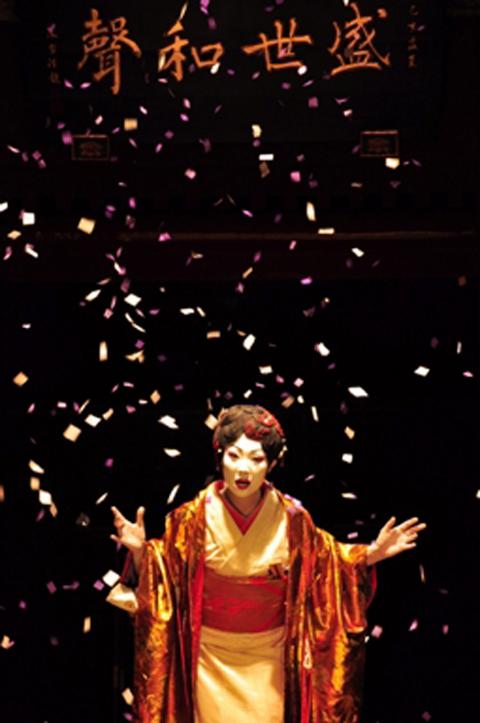The Coy Hunchback Steals His Maternal Decree (作淫愁(下部)猶自羞駝男盜令), the latest work by Theatre Company of Lee Qing Zhao the Private (李清照私人劇團), will be staged at Treasure Hill Artist Village (寶藏巖國際藝術村) for six performances from Sunday through Oct. 28.
Written and directed by Liu Liang-yen (劉亮延), the play, a mix of sexual deviancy and tongue-in-cheek humor, blends Japanese avant-garde theater master Shuji Terayama’s The Hunchback of Aomori and Beijing opera classic Silang Visits His Mother (四郎探母) to investigate the psyche of a man who abandons his wife to find his mother, who welcomes him into her bed.
“It’s very typical of Terayama’s works, which are very dark and funny at the same time,” director Liu told the Taipei Times at a rehearsal on Tuesday.

Photo Courtesy of Theatre Company of Lee Qing Zhao the Private
The play features Japanese theater actor Yoshiaki Yamashita in the title role, Taiwanese actress Chien Yu-shan (錢宇珊) as a princess, director Liu himself as the hunchback’s mother, and Japanese actress Yuumi Sakakibara as a narrator.
The story follows the hunchback as he goes to war, is captured by the enemy and marries a princess of the enemy nation. Homesick, the hunchback steals an exit decree to return to his hometown. When the princess goes looking for her husband, she is shocked at what she discovers.
“Every man is looking for a mother,” Liu said with a winking smirk. “It’s such a hopeless thing.”
To realize his wicked sense of melodrama, Liu serves out an uncanny mixture of visual flair, irreverent humor, and a through-the-roof fun quotient complete with singing and dancing. All the actors perform in extravagant Japanese kimonos, and the play includes segments of Beijing opera songs and nihon buyo dancing. The Japanese and Taiwanese actors will each perform in their native languages, with Chinese subtitles.
The Coy Hunchback is part two of director Liu’s production Marie Educates Her Son at Virgin Flowers Falling (初飛花瑪莉訓子), which premiered in May and was nominated for a Taishin Arts Award (台新藝術獎).
The performance will be accompanied by a free show at 6pm: the solo dance Shreds and Trace (殘跡) on Sunday and Monday, and the monologue play Ciao, Ci Chao in Seven (七人曹七巧) from Tuesday to Oct. 28.

May 11 to May 18 The original Taichung Railway Station was long thought to have been completely razed. Opening on May 15, 1905, the one-story wooden structure soon outgrew its purpose and was replaced in 1917 by a grandiose, Western-style station. During construction on the third-generation station in 2017, workers discovered the service pit for the original station’s locomotive depot. A year later, a small wooden building on site was determined by historians to be the first stationmaster’s office, built around 1908. With these findings, the Taichung Railway Station Cultural Park now boasts that it has

Wooden houses wedged between concrete, crumbling brick facades with roofs gaping to the sky, and tiled art deco buildings down narrow alleyways: Taichung Central District’s (中區) aging architecture reveals both the allure and reality of the old downtown. From Indigenous settlement to capital under Qing Dynasty rule through to Japanese colonization, Taichung’s Central District holds a long and layered history. The bygone beauty of its streets once earned it the nickname “Little Kyoto.” Since the late eighties, however, the shifting of economic and government centers westward signaled a gradual decline in the area’s evolving fortunes. With the regeneration of the once

The latest Formosa poll released at the end of last month shows confidence in President William Lai (賴清德) plunged 8.1 percent, while satisfaction with the Lai administration fared worse with a drop of 8.5 percent. Those lacking confidence in Lai jumped by 6 percent and dissatisfaction in his administration spiked up 6.7 percent. Confidence in Lai is still strong at 48.6 percent, compared to 43 percent lacking confidence — but this is his worst result overall since he took office. For the first time, dissatisfaction with his administration surpassed satisfaction, 47.3 to 47.1 percent. Though statistically a tie, for most

In February of this year the Taipei Times reported on the visit of Lienchiang County Commissioner Wang Chung-ming (王忠銘) of the Chinese Nationalist Party (KMT) and a delegation to a lantern festival in Fuzhou’s Mawei District in Fujian Province. “Today, Mawei and Matsu jointly marked the lantern festival,” Wang was quoted as saying, adding that both sides “being of one people,” is a cause for joy. Wang was passing around a common claim of officials of the People’s Republic of China (PRC) and the PRC’s allies and supporters in Taiwan — KMT and the Taiwan People’s Party — and elsewhere: Taiwan and